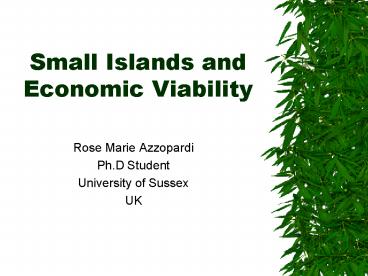Small Islands and Economic Viability - PowerPoint PPT Presentation
1 / 18
Title:
Small Islands and Economic Viability
Description:
In terms of GDP per capita, six out of 10 richest countries are small states ... Sugar, bananas, fish, copra, cocoa. Secondary Sector ... – PowerPoint PPT presentation
Number of Views:35
Avg rating:3.0/5.0
Title: Small Islands and Economic Viability
1
Small Islands and Economic Viability
- Rose Marie Azzopardi
- Ph.D Student
- University of Sussex
- UK
2
Main Question
- Are small islands helpless or resourceful?
3
The Claims and the Empirical Evidence
- Disadvantages and Advantages
- In terms of GDP per capita, six out of 10 richest
countries are small states - Islandness is not statistically significant
- Contradictory
- Inconclusive
4
and
- Salvatore (2001) excludes from his analysis
nations with less than 1 million population
often small island nations with only a few
thousand people and little economic significance - MIRAB, PROFIT, Non-market solutions
- Vulnerability index
5
My Paper
- 26 small independent island states, 30km²land
area, 1.5 million population - arguing that successful islands are more focused
on invisibles rather than visibles, services
rather than manufacturing, to override
transportation costs - reassessment of successful islands still needed
due to - erosion of trade preferences
- stricter rules in financial activities
- widening remit of the WTO
- regionalism
6
The Hard Facts
- High Income (4 islands) (4/78) 5.1
- Upper Middle (11 islands) (11/64) 17.2
- Lower Middle (8 islands) (8/58) 13.8
- Low Income (3 islands) (3/8) 37.5
7
Region
- Mediterranean islands high income
- Persian Gulf (high income)
- Caribbean islands upper middle
- Pacific (except Palau) all lower end
- Atlantic and Indian (mixed groups)
8
GNI per capita of neighbour
- Pacific all lower
- Indian Ocean and Persian Gulf all above
- Caribbean 6 lower, 2 higher
- Atlantic 2 lower, 1 higher
- Mediterranean, 1 lower, 1 higher
9
Dependence on trade and Openness of the economy
- All islands import more than average of group
- Only 4 export less than average of group
- Except for Comoros, all islands have very open
economies, above world average and above group
averages
10
Sectoral ActivityPrimary Sector
- Majority of islands are above group average (ex
Sao Tome Principe, Cape Verde, Bahrain, UM5) - dependence on agriculture, fisheries, forestry
- subsistence and exports
- Sugar, bananas, fish, copra, cocoa
11
Secondary Sector
- Almost all islands are below group average (ex.
Seychelles, T T, Bahrain) - scale for competition transportation costs
- industrialization is not heavy on islands,
normally food processing and textiles - Bahrain - petroleum products and aluminium
- T T - petroleum products, chemicals and steel
- Seychelles - canned tuna and frozen fish
12
Tertiary Sector
- Almost all islands are above group average (ex
Comoros, Solomon Is. Fiji, T T, Bahrain) - High concentration on services, which includes
government - Almost all have tourism as one of their main
industries, followed by offshore banking
13
GNI per capita
- Only 9 out of 26 are above the world GNI per
capita average of 5500 - High income average is 28,550
- While the four islands in this group range from
9,260 to 15,110 - all well below the group
average
14
Sectoral Employment
- Only the four high income islands have single
digit percentages of employed people in the
primary sector - Light industry for most islands and not many
people employed in the secondary sector - Islands with at least 64 employed in tertiary
sector are either in high or upper middle groups
and their GNI per capita is above 7000.
15
Other issues for consideration
- Tax havens 15(18)/26 OECD 1998 list
- Trade concessions (REPAs, WTO)
- Donor fatigue (ODA decreased by 1/3 in real terms
in the 1990s) World Bank, surveillance,
effectiveness, package deal - Regionalism -innocent bystander dilemma
- Informal economy - multiple jobs, small family
enterprises
16
Summing Up
- Islands still too dependent on primary sector
- Manufacturing not affordable, unless one has
developed a niche market (Bahrain, Seychelles) - Focus on services should not be restricted to
tourism due to increased competition
17
Concluding comments
- Data analysis inconclusive on helpless/resourceful
dichotomy - Mixture of external management blended with a
variety of internal policies - Each island must design its own mode of
development, based on own geographical, cultural
and social realities, yet remaining open to new
ideas and engaging more with the global economic
environment
18
Thank you































